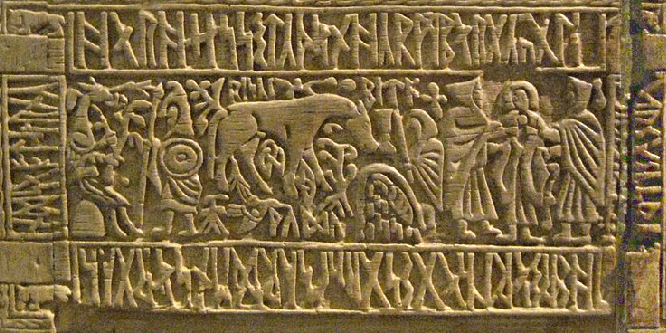1. The Artwork of the Sons of the Vikings

This is a classical image from the famous album of
the British rock group Whitesnake. Debates have arisen over
whether this scene should be regarded as obscene. When the album
›Lovehunter‹ came out, in the rocky 1980's, it raised
protests; and some record shops only sold it with a neutral cover.
Strictly judged the woman in front only shows her naked behind. Such
nude scenes are still not pornographic. But definitely this is an
erotic scene of a girl with that white fantasy snake. The beautiful
redhead rises her head in lust, while the mood of the snake seems to
be likewise excited. What we see here has definitely something to do
with witchcraft. That image asks the question: Who is this snake
supposed to be? That question exceeds the borders of old-time human
wisdom. The two horns of the vicious looking snake remind of the
traditional horns of a devil. The UTR teaches that by their skin
colour, the good gods and angels and the evil Greys are
distinguishable. The good snakes wear white, while the skin of the
zombie-like Greys is grey and in a rotten state. Also the famous book
›The White Goddess‹ of Robert Graves points out that
our Earth Goddess has white skin as her characteristic feature. On
this image her vision however seems to be blurred and mixed with that
of the Greys. These often interfere with their evil creativity when
they search for lifeforce. Our White Goddess however is indeed a
"lovehunter". Sofia Ewa loves her evolved creatures. The
two to six horns or wings of such a fantasy alien often symbolize her
blood cranes. On this image the split tongue is a sign of warning.
That snake is not symbolizing a truthful spirit.
I remember well the great songs of that rock group.
Forty years ago, or so, I used to be a fan of rock music. Today the
Wikipedia has it, that Whitesnake only became a classical
super-group when the keyboarder Jon Lord joined it. Like the founder
of the group, David Coverdale, Jon Lord had come from the group Deep
Purple. That British rock group was, in the Seventies of the past
century, the biggest and hardest of a new era. It was also a group
that used many themes of classical music and old-time religion. One
of their greatest hits was ›Smoke on the Water‹. I
remember that I didn't like really like it, but it seemed to touch
something in the hearts of many people of that era, who were still
moreless Christians. But, like their ancestors from the age of the
Vikings, those young Christians must have had the bitter idea that
they would end up in hell since they weren't in God's favour. That is
why they howled like hell-hounds in ›Child in Time‹.
Smoke on the Water, Fire in the Sky (the original
title was: Durh, Durh, Durh)
That is the main text line of the big Deep
Purple hit ›Smoke on the Water‹. The text tells us
that the group was in Montreux, Switzerland, when a catastrophe
occurred there. The dark bizarre gay US-musician Frank Zappa had been
performing there with his band, the Mothers of Invention, in a
casino. But the story goes that some »stupid with a flare gun«
burned that place to the ground. So what? The secret of the success
of this rather plain and conventional rock song was, that it told a
message of apocalypse. That again must have alluded to the secret
fears of Christian rock fans. But their big problem was and still is,
that Jesus is dead and not in the skies, with Zarathustra and all the
other puny prophets of old time. With courage and luck our real
existing White Snake also tries to educate our youth. During the
mid-seventies Sofia Ewa had heard enough of Deep Purple and
decided to withhold God's creativity. Their music became dull, and
then they split up and left.
Strange is that the first really successful album of
the rock group Deep Purple was called after the book of the famous
Welsh bard Taliesyn. That shows that fractal connections existed to
the Welshmen of our neighbouring planet Lar. And then the name
Jonathan Lord strongly links to our second-next living planet Sesam.
The local saviour of Ga-Rina's planet is called Jonathan.
In the early Seventies Deep Purple was the
loudest rock group influencing the tougher of the younger ones. They
best performed live, for instance in Japan. Commentators fame the
»duels«, that the keyboarder Jon Lord and his guitarist
Ritchie Blackmore would play out for many minutes. Much has been
written about their metal music, but of course this set also has a
spiritual dimension. Believing people could see in Mr. Lord some
likeness of God the Father, while Mr. Blackmore represented the
Swarthy Man, the mythical anti- deity of not only the Christians. The
tension between these two leading musicians of the band also reflects
the tension between God and the Devil in Christian mythology. That is
of course one aspect of diversity. It may seem that our life would be
dull if not slavish, if directed by an over-powerful God only.
Doesn't such a tyrannical god like the Yahweh of the Bible need a
wild rebel as counterpart for to make life more exciting and diverse?
On stage these "duels" definitely made the music win power.
But the tale of ›Smoke on the Water‹ should warn us
that it is risky to play with the forces of evil. The cosmic demons
are in fact not the counterparts of an almighty lord, whose role it
is to challenge Him and to punish the sinners, for the sake of a more
diverse and entertaining creation. In truth those cosmic Greys are
our mindless enemies, who try to thoroughly wreck our earths.




